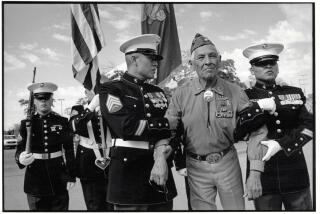Arizona Cowboys, Masai Warriors Are Equally at Home on the Range
- Share via
NAIROBI, Kenya — Masai warriors and Arizona cowboys appreciate many of the same things -- healthy cattle, roasted meat and the open plains -- so it’s no wonder they struck up a friendship.
A group of Masai departed for Arizona recently to learn how to merge ancient Kenyan traditions with modern American agro-economics, reciprocation for a visit by a group of Arizona cowboys in 2002.
Ranchers from the Douglas, Ariz.-based Malpai Borderlands Group will be showing off the conservation and economic benefits of open rangelands when Masai from Kenya and Tanzania spend a week with them.
The Arizona ranchers came to Kenya in October 2002 and shared their experiences with the Masai, who, like themselves, have resisted government pressure to fence in their land and drive off wildlife, said James Ndung’u of the African Conservation Center, which helped the two groups meet.
During the Americans’ stay, Yusuf Ole Petenya listened to Bill Miller and his wife, Carol, share their life story over a meal of nyama choma -- or roast meat, a must-have in Kenya -- and recognized his own.
“They live like Masai, but their environment is different. They do things according to the clock,” Petenya said. “Once a Masai starts grazing his cattle, he’s not in a hurry.”
But many other things were the same.
“They milk their cattle, graze them, water them, take them to dips just like we do. Even they were surprised there were similarities between the Masai and cowboys,” Petenya said.
The Malpai Borderlands Group’s ranch runs across Arizona and New Mexico along the border with Mexico. The Masai tribe, known for its spectacular jewelry and distinctive red clothing, is also a border community, living in the savannas of southern Kenya and neighboring northern Tanzania.
Like the Masai, the Malpai ranchers not only think of their herds when pondering the future, they also keep in mind the wildlife that shares the open rangelands, such as the endangered Mexican jaguar, the recently reintroduced thick-billed parrots or the rare Chiricahua leopard frog.
“We believe that our work will continue to show that cattle are not just compatible with rare species, but often they are beneficial. We’ve found that if you do the right thing for one, it tends to help the other,” Bill McDonald, the group’s executive director, said on its website.
The Masai have learned over generations to coexist with wildlife and turned that knowledge to their advantage by creating conservation areas.
One group, the Shompole Community Trust, noted that a trickle of tourists came soon after seeing the 1985 Oscar-winning “Out of Africa,” which was partly filmed on Shompole land.
The community built the Shompole Safari Lodge with the help of the African Conservation Center to raise much-needed cash from tourists eager to see lions, cheetah, elephants and the endangered African wild dog.
Petenya said his American visitors told him that they too had come under pressure from government officials to modernize and change their ways, to graze their cattle on less land, to subdivide their property or quit ranching all together.
When the Malpai ranchers subdivided their rangeland, which totals 800,000 acres, cattle overgrazed the smaller, 100-acre plots, which adversely affected the environment and the wildlife that had lived there. Eventually, they opened up some of their prairies and are working to restore all of them.
In 2002, Malpai ranchers decided to reach out to other ranchers with similar experiences because “after going through the bad stages and then the recovery, they thought they owed it” to others to share what they’d learned, Ndung’u said.
Petenya said he hoped to learn the skills that the Malpai Borderlands Group used to lobby officials and lawmakers to rethink policies on ranching so that “we can try to form a group here that can access [President Mwai] Kibaki” and hopefully avoid the same mistakes.
More to Read
Sign up for Essential California
The most important California stories and recommendations in your inbox every morning.
You may occasionally receive promotional content from the Los Angeles Times.













